Leilei Sun
Beijing University of Aeronautics and Astronautics
Improving Temporal Link Prediction via Temporal Walk Matrix Projection
Oct 05, 2024



Abstract:Temporal link prediction, aiming at predicting future interactions among entities based on historical interactions, is crucial for a series of real-world applications. Although previous methods have demonstrated the importance of relative encodings for effective temporal link prediction, computational efficiency remains a major concern in constructing these encodings. Moreover, existing relative encodings are usually constructed based on structural connectivity, where temporal information is seldom considered. To address the aforementioned issues, we first analyze existing relative encodings and unify them as a function of temporal walk matrices. This unification establishes a connection between relative encodings and temporal walk matrices, providing a more principled way for analyzing and designing relative encodings. Based on this analysis, we propose a new temporal graph neural network called TPNet, which introduces a temporal walk matrix that incorporates the time decay effect to simultaneously consider both temporal and structural information. Moreover, TPNet designs a random feature propagation mechanism with theoretical guarantees to implicitly maintain the temporal walk matrices, which improves the computation and storage efficiency. Experimental results on 13 benchmark datasets verify the effectiveness and efficiency of TPNet, where TPNet outperforms other baselines on most datasets and achieves a maximum speedup of $33.3 \times$ compared to the SOTA baseline. Our code can be found at \url{https://github.com/lxd99/TPNet}.
DyGKT: Dynamic Graph Learning for Knowledge Tracing
Jul 30, 2024



Abstract:Knowledge Tracing aims to assess student learning states by predicting their performance in answering questions. Different from the existing research which utilizes fixed-length learning sequence to obtain the student states and regards KT as a static problem, this work is motivated by three dynamical characteristics: 1) The scales of students answering records are constantly growing; 2) The semantics of time intervals between the records vary; 3) The relationships between students, questions and concepts are evolving. The three dynamical characteristics above contain the great potential to revolutionize the existing knowledge tracing methods. Along this line, we propose a Dynamic Graph-based Knowledge Tracing model, namely DyGKT. In particular, a continuous-time dynamic question-answering graph for knowledge tracing is constructed to deal with the infinitely growing answering behaviors, and it is worth mentioning that it is the first time dynamic graph learning technology is used in this field. Then, a dual time encoder is proposed to capture long-term and short-term semantics among the different time intervals. Finally, a multiset indicator is utilized to model the evolving relationships between students, questions, and concepts via the graph structural feature. Numerous experiments are conducted on five real-world datasets, and the results demonstrate the superiority of our model. All the used resources are publicly available at https://github.com/PengLinzhi/DyGKT.
Co-Neighbor Encoding Schema: A Light-cost Structure Encoding Method for Dynamic Link Prediction
Jul 30, 2024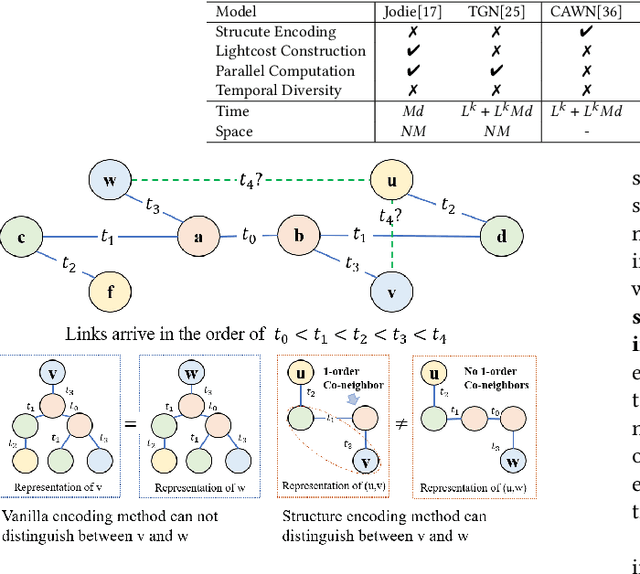
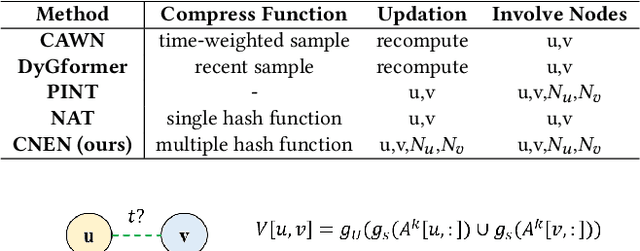
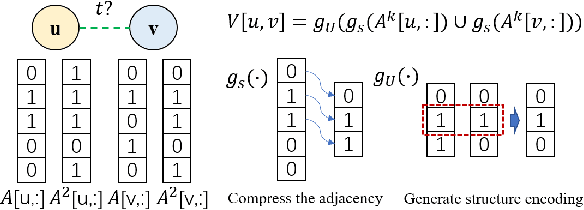
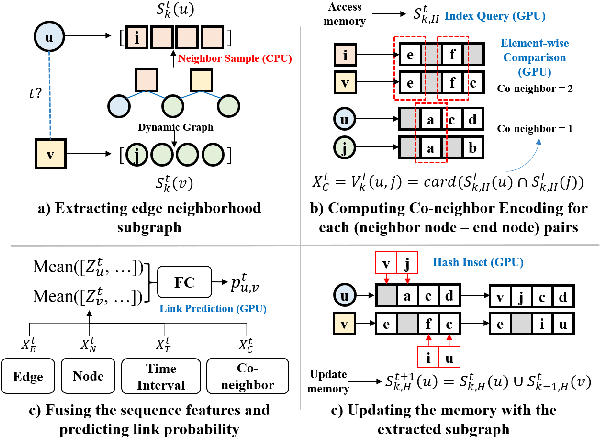
Abstract:Structure encoding has proven to be the key feature to distinguishing links in a graph. However, Structure encoding in the temporal graph keeps changing as the graph evolves, repeatedly computing such features can be time-consuming due to the high-order subgraph construction. We develop the Co-Neighbor Encoding Schema (CNES) to address this issue. Instead of recomputing the feature by the link, CNES stores information in the memory to avoid redundant calculations. Besides, unlike the existing memory-based dynamic graph learning method that stores node hidden states, we introduce a hashtable-based memory to compress the adjacency matrix for efficient structure feature construction and updating with vector computation in parallel. Furthermore, CNES introduces a Temporal-Diverse Memory to generate long-term and short-term structure encoding for neighbors with different structural information. A dynamic graph learning framework, Co-Neighbor Encoding Network (CNE-N), is proposed using the aforementioned techniques. Extensive experiments on thirteen public datasets verify the effectiveness and efficiency of the proposed method.
Research on Foundation Model for Spatial Data Intelligence: China's 2024 White Paper on Strategic Development of Spatial Data Intelligence
May 30, 2024Abstract:This report focuses on spatial data intelligent large models, delving into the principles, methods, and cutting-edge applications of these models. It provides an in-depth discussion on the definition, development history, current status, and trends of spatial data intelligent large models, as well as the challenges they face. The report systematically elucidates the key technologies of spatial data intelligent large models and their applications in urban environments, aerospace remote sensing, geography, transportation, and other scenarios. Additionally, it summarizes the latest application cases of spatial data intelligent large models in themes such as urban development, multimodal systems, remote sensing, smart transportation, and resource environments. Finally, the report concludes with an overview and outlook on the development prospects of spatial data intelligent large models.
Regions are Who Walk Them: a Large Pre-trained Spatiotemporal Model Based on Human Mobility for Ubiquitous Urban Sensing
Nov 17, 2023Abstract:User profiling and region analysis are two tasks of significant commercial value. However, in practical applications, modeling different features typically involves four main steps: data preparation, data processing, model establishment, evaluation, and optimization. This process is time-consuming and labor-intensive. Repeating this workflow for each feature results in abundant development time for tasks and a reduced overall volume of task development. Indeed, human mobility data contains a wealth of information. Several successful cases suggest that conducting in-depth analysis of population movement data could potentially yield meaningful profiles about users and areas. Nonetheless, most related works have not thoroughly utilized the semantic information within human mobility data and trained on a fixed number of the regions. To tap into the rich information within population movement, based on the perspective that Regions Are Who walk them, we propose a large spatiotemporal model based on trajectories (RAW). It possesses the following characteristics: 1) Tailored for trajectory data, introducing a GPT-like structure with a parameter count of up to 1B; 2) Introducing a spatiotemporal fine-tuning module, interpreting trajectories as collection of users to derive arbitrary region embedding. This framework allows rapid task development based on the large spatiotemporal model. We conducted extensive experiments to validate the effectiveness of our proposed large spatiotemporal model. It's evident that our proposed method, relying solely on human mobility data without additional features, exhibits a certain level of relevance in user profiling and region analysis. Moreover, our model showcases promising predictive capabilities in trajectory generation tasks based on the current state, offering the potential for further innovative work utilizing this large spatiotemporal model.
Pretraining Language Models with Text-Attributed Heterogeneous Graphs
Oct 23, 2023Abstract:In many real-world scenarios (e.g., academic networks, social platforms), different types of entities are not only associated with texts but also connected by various relationships, which can be abstracted as Text-Attributed Heterogeneous Graphs (TAHGs). Current pretraining tasks for Language Models (LMs) primarily focus on separately learning the textual information of each entity and overlook the crucial aspect of capturing topological connections among entities in TAHGs. In this paper, we present a new pretraining framework for LMs that explicitly considers the topological and heterogeneous information in TAHGs. Firstly, we define a context graph as neighborhoods of a target node within specific orders and propose a topology-aware pretraining task to predict nodes involved in the context graph by jointly optimizing an LM and an auxiliary heterogeneous graph neural network. Secondly, based on the observation that some nodes are text-rich while others have little text, we devise a text augmentation strategy to enrich textless nodes with their neighbors' texts for handling the imbalance issue. We conduct link prediction and node classification tasks on three datasets from various domains. Experimental results demonstrate the superiority of our approach over existing methods and the rationality of each design. Our code is available at https://github.com/Hope-Rita/THLM.
Self-optimizing Feature Generation via Categorical Hashing Representation and Hierarchical Reinforcement Crossing
Sep 14, 2023Abstract:Feature generation aims to generate new and meaningful features to create a discriminative representation space.A generated feature is meaningful when the generated feature is from a feature pair with inherent feature interaction. In the real world, experienced data scientists can identify potentially useful feature-feature interactions, and generate meaningful dimensions from an exponentially large search space, in an optimal crossing form over an optimal generation path. But, machines have limited human-like abilities.We generalize such learning tasks as self-optimizing feature generation. Self-optimizing feature generation imposes several under-addressed challenges on existing systems: meaningful, robust, and efficient generation. To tackle these challenges, we propose a principled and generic representation-crossing framework to solve self-optimizing feature generation.To achieve hashing representation, we propose a three-step approach: feature discretization, feature hashing, and descriptive summarization. To achieve reinforcement crossing, we develop a hierarchical reinforcement feature crossing approach.We present extensive experimental results to demonstrate the effectiveness and efficiency of the proposed method. The code is available at https://github.com/yingwangyang/HRC_feature_cross.git.
Adaptive Taxonomy Learning and Historical Patterns Modelling for Patent Classification
Aug 10, 2023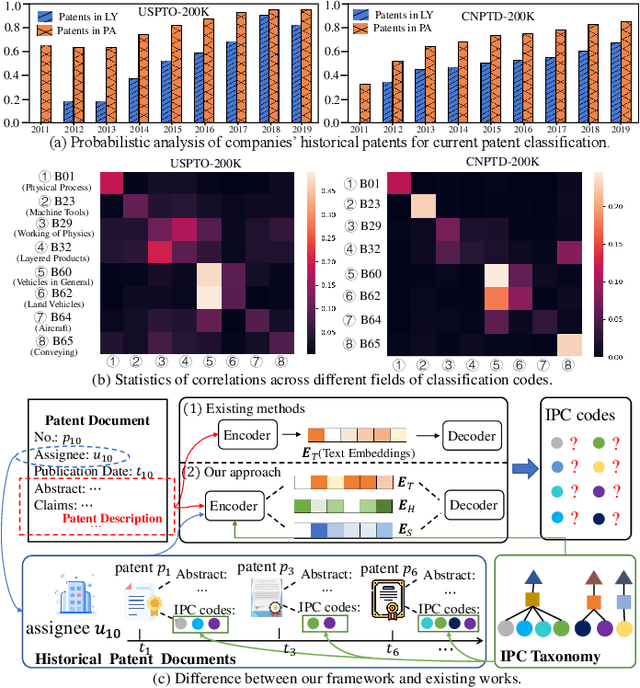

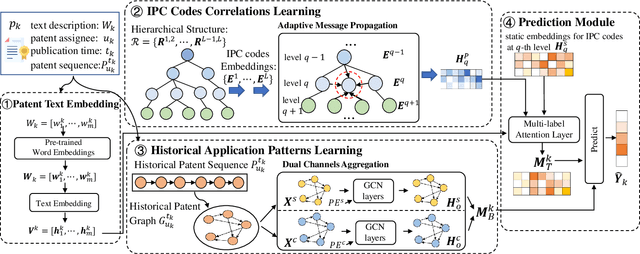
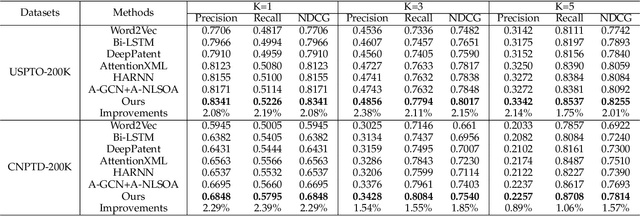
Abstract:Patent classification aims to assign multiple International Patent Classification (IPC) codes to a given patent. Recent methods for automatically classifying patents mainly focus on analyzing the text descriptions of patents. However, apart from the texts, each patent is also associated with some assignees, and the knowledge of their applied patents is often valuable for classification. Furthermore, the hierarchical taxonomy formulated by the IPC system provides important contextual information and enables models to leverage the correlations between IPC codes for more accurate classification. However, existing methods fail to incorporate the above aspects. In this paper, we propose an integrated framework that comprehensively considers the information on patents for patent classification. To be specific, we first present an IPC codes correlations learning module to derive their semantic representations via adaptively passing and aggregating messages within the same level and across different levels along the hierarchical taxonomy. Moreover, we design a historical application patterns learning component to incorporate the corresponding assignee's previous patents by a dual channel aggregation mechanism. Finally, we combine the contextual information of patent texts that contains the semantics of IPC codes, and assignees' sequential preferences to make predictions. Experiments on real-world datasets demonstrate the superiority of our approach over the existing methods. Besides, we present the model's ability to capture the temporal patterns of assignees and the semantic dependencies among IPC codes.
Event-based Dynamic Graph Representation Learning for Patent Application Trend Prediction
Aug 04, 2023Abstract:Accurate prediction of what types of patents that companies will apply for in the next period of time can figure out their development strategies and help them discover potential partners or competitors in advance. Although important, this problem has been rarely studied in previous research due to the challenges in modelling companies' continuously evolving preferences and capturing the semantic correlations of classification codes. To fill in this gap, we propose an event-based dynamic graph learning framework for patent application trend prediction. In particular, our method is founded on the memorable representations of both companies and patent classification codes. When a new patent is observed, the representations of the related companies and classification codes are updated according to the historical memories and the currently encoded messages. Moreover, a hierarchical message passing mechanism is provided to capture the semantic proximities of patent classification codes by updating their representations along the hierarchical taxonomy. Finally, the patent application trend is predicted by aggregating the representations of the target company and classification codes from static, dynamic, and hierarchical perspectives. Experiments on real-world data demonstrate the effectiveness of our approach under various experimental conditions, and also reveal the abilities of our method in learning semantics of classification codes and tracking technology developing trajectories of companies.
Learning Joint 2D & 3D Diffusion Models for Complete Molecule Generation
May 21, 2023Abstract:Designing new molecules is essential for drug discovery and material science. Recently, deep generative models that aim to model molecule distribution have made promising progress in narrowing down the chemical research space and generating high-fidelity molecules. However, current generative models only focus on modeling either 2D bonding graphs or 3D geometries, which are two complementary descriptors for molecules. The lack of ability to jointly model both limits the improvement of generation quality and further downstream applications. In this paper, we propose a new joint 2D and 3D diffusion model (JODO) that generates complete molecules with atom types, formal charges, bond information, and 3D coordinates. To capture the correlation between molecular graphs and geometries in the diffusion process, we develop a Diffusion Graph Transformer to parameterize the data prediction model that recovers the original data from noisy data. The Diffusion Graph Transformer interacts node and edge representations based on our relational attention mechanism, while simultaneously propagating and updating scalar features and geometric vectors. Our model can also be extended for inverse molecular design targeting single or multiple quantum properties. In our comprehensive evaluation pipeline for unconditional joint generation, the results of the experiment show that JODO remarkably outperforms the baselines on the QM9 and GEOM-Drugs datasets. Furthermore, our model excels in few-step fast sampling, as well as in inverse molecule design and molecular graph generation. Our code is provided in https://github.com/GRAPH-0/JODO.
 Add to Chrome
Add to Chrome Add to Firefox
Add to Firefox Add to Edge
Add to Edge